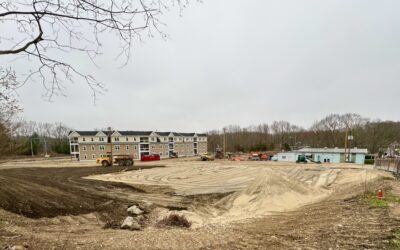Above: The building at 1600 Division Road MedRecyleRI has leased for its operations.
Environmentalists question safety of technique; East Greenwich wants more information
By Hope McKinney
To hear MedRecycleRI CEO Nicholas Campanella talk about pyrolysis – the method he plans to use at a West Warwick facility on the border of East Greenwich – this technology will in effect burn medical waste without the pollution usually caused by incineration and create renewable energy in the process.

The proposed medical recycler at 1600 Division Road may sit in West Warwick but it is only accessible through East Greenwich.
MedRecycleRI has already cleared one hurdle in this quest: it secured a “minor source” air permit from the state Dept. of Environmental Management May 7. It still needs more approvals from the Town of West Warwick and a “major source” solid-waste permit from DEM before it can begin operations. But the Town of East Greenwich has appealed DEM’s decision on the air permit at both the agency level and in state Superior Court, arguing that DEM shouldn’t have approved it without more information about what exactly was going to be processed. The appeals also say MRI failed to provide DEM with an example of another facility utilizing their technology to process medical waste.
The facility is proposed for 1600 Division Road, in a part of West Warwick that borders East Greenwich and, in fact, is only accessible via East Greenwich roads.
Environmentalists say using pyrolysis for plastics (which will presumably constitute at least some of what MedRecycleRI processes) is not safe.
Campanella, of New Jersey, said the facility will create jobs (up to 100 jobs during construction and dozens of permanent jobs when operational), ease the burden on the state’s main landfill, and generate renewable energy.
According to the MRI website, “Pyrolysis indirectly heats organic compounds thereby evaporating them into syngas [synthetic fuel] that can then be used by engines to create electricity.”
Campanella said emissions from the plant would be minimal. “Equal to only four cars per year – a tiny fraction of those generated by a nearby heavy industrial facility, or New England Tech across the street,” said Campanella.
New England Tech, at 1 New England Tech Boulevard, has joined EG’s Superior Court appeal.
Kevin Budris, with the Conservation Law Foundation (an environmental advocacy organization), said pyrolysis is bound to cause pollution, particularly when the medical waste is plastic.
“The type of pyrolysis facility that they’re proposing for West Warwick is, in effect, just another form of incineration,” he said. “Whether you call it incineration, or pyrolysis, or gasification, or any other type of term used to refer to this kind of high-heat waste treatment, you are burning medical waste.”
He said medical waste is usually about 25 percent plastic. Budris said burning plastic using any type of high-heat process is toxic and this is one of the main reasons the World Health Organization discourages burning medical waste (read more HERE). Budris said burning medical waste also creates a significant amount of dioxin emissions – dioxins are pollutants linked to cancer, liver damage, infertility and birth defects.
Campanella, however, said pyrolysis doesn’t involve burning or incineration because there’s no oxygen involved, thus preventing dioxins from forming.
“This is a treatment which can be applied to any organic (carbon-based) product, like plastic,” Campanella said. “It is similar to melting, although not quite the same. In this treatment, material is exposed to high temperatures up to 1,500 degrees Fahrenheit, and in the absence of oxygen goes through chemical and physical separation into different molecules.”
He added, “Because there is no burning or incineration of material, emissions from the facility will be negligible.”
DEM’s Gail Mastrati said MedRecycler was required to install a thermal oxidizer in order to get approved for its minor source air permit. She said this thermal oxidizer is where all the emissions streams will be routed.
“A thermal oxidizer is considered the best air pollution control technology to destroy the pollutants that would be potentially emitted from the facility, including dioxins,” Mastrati said. “MedRecycler is also required under its air permit to test the thermal oxidizer exhaust stream for many pollutants, including dioxins.”
CLF’s Budris said it’s unclear how effective the thermal oxidizer will be at controlling dioxin emissions because MRI’s application to DEM doesn’t discuss dioxins. He also said it isn’t specified how frequently the company would be required to monitor dioxin emissions.
“There is a big difference, for example, between quarterly monitoring and continuous emissions monitoring,” he said. “And although monitoring may be required, it does not sound like the permit sets an emissions limit for dioxins. Without an emissions limit, a monitoring requirement will do little to protect the community.”
Budris said it’s a major concern that MedRecycler didn’t include plans to prevent dioxin emissions in their submission to the Department of Environmental Management.
He also said many healthcare facilities have moved away from burning medical waste and toward programs to reduce their trash and single-use plastic waste. Rhode Island Hospital, for instance, has implemented a program where they collect some of the waste from their operating rooms – the sterile wrap used on sterile instruments – so it can be recycled. According to DEM, Rhode Island hospitals stopped burning waste back in the 1990s.
“This pyrolysis facility that’s proposed for West Warwick would be a step backward,” Budris said.
One question that’s persisted is what exactly MRI is going to be recycling.
Campanella said he’s looking to recycle “the type of common waste normally generated when people visit doctor’s offices, hospitals or dentists. These items, often commonly found in homes as well, include band-aids, bandages, tongue depressors, Q-Tips, cotton balls, etc.”
In the MedRecycleRI application, however, the types of waste listed included pathological and anatomical waste, human waste, blood and blood products, sharps (needles), animal waste, hazardous waste, chemical waste, cultures and stocks. Wastes that would not be accepted include etiologic agents, radioactive waste, RCRA empty chemotherapeutic or cytotoxic wastes, isolation wastes and prions or OD infected waste, or by-products.
MRI still has to get a “major source” solid waste permit from DEM. That process, unlike for minor source permits, requires a public hearing where the Town of East Greenwich would be a participant.
CLF’s Budris said pyrolysis generates solid waste like ash, char and tar, which are the solid waste products left over after the medical waste is heated to create the synthetic fuel.
“That ash and char also contains high levels of dangerous pollutants,” he said. “And so, you’re left with a dangerous waste product which, oftentimes, is burned. It’s important to recognize that the pyrolysis process doesn’t magically convert waste into energy.”
Pyrolysis has never been used on medical waste.
The system MRI plans to use comes from Technotherm, Inc., a company located in South Africa. There are three other waste-to-energy projects completed and in progress using Technotherm technology: The first is in Knoostad, South Africa, with waste used from an animal slaughterhouse. The second is in Ecorevert-Wadeville, South Africa, using all types of waste and “design for plastic.” The third is in Huntington, United Kingdom, using biomass (wood).
Campanella said he decided to open a facility in Rhode Island because of the state’s renewable energy and job creation initiatives. Originally, MedRecycleRI was going to open up in Johnston and in fact got the go ahead to open there.
“As Mayor of Johnston, I wholeheartedly welcome MedRecycler,” Mayor Joseph Polisena wrote in a letter of approval for the facility in 2019. “I am truly excited to have such a development be part of the town of Johnston’s future.”
But Campanella said he shifted to West Warwick after the owner of the Johnston site raised the rent. He said West Warwick was also chosen for its location right off Route 95 and because of the reception he’s received from the town.
“We’ve been working with them for over a year, and in that time they have consistently been focused on the facts, not politics,” he said. “Out-of-state businesses know which towns support economic growth, and which towns are run by politicians who are more interested in election-year political grandstanding.”
Campanella complained that some politicians were making inaccurate characterizations. He declined to be more specific, although EG Town Councilor Renu Englehart, who happens to live about a mile up Division Road from the proposed site, has raised a number of questions about the safety of such a facility as well as about the money it’s gotten from the state.
“I am concerned about MedRecycleRI and their intended use of pyrolysis for medical waste. This is very close to residential areas as well as a preschool and NEIT. The company cited at least two facilities as comparisons in documents that I have seen. One was in Florida and it closed shortly after opening. The other was Monarch Waste Technologies located in rural New Mexico. In an article regarding Monarch Waste, a resident stated he could smell the waste facility all the time [read more HERE]. The two other pyrolysis plants cited by MRI in the U.S. do not process medical waste. We do not know what the byproduct gasses are, but they do mention sodium sulfide, which is a poisonous gas,” Englehart said via email, adding, “Since this technology is so new, how will West Warwick safeguard residents and students if there is a problem?”
Englehart also wanted to know how the State of Rhode Island and Commerce RI “have approved $17 million in revenue development bonds for MRI without appearing to receive independent review of this project.”
Campanella urged residents with questions to check out the company’s website (find it HERE).
“We see MedRecycler as a great opportunity to be a positive addition to Rhode Island’s green energy space and to help the state meet its ambitious renewable goals,” Campanella said. “At the same time, we’ll provide a better, cleaner way to reduce the amount of waste that would normally go to the landfill.”
Meanwhile, the Town of East Greenwich’s appeals have been filed and the West Warwick Planning Board is looking to hire an expert to review MRI’s application, at the expense of Campanella.
“If there is anything negative or anything that needs to be addressed,” said West Warwick Town Planner Mark Carruolo, “the town will have a professional on its side, looking at it, making us aware and making suggestions or recommendations as to what we should do.”
Read previous EG News stories about MedRecycleRI:
Town Appeals Permit for West Warwick Medical Waste Plant
EG Seeks More Input on Planned West Warwick Recycling Plant
Hope McKinney is a journalism major at the University of Rhode Island, class of 2020. She’s originally from South Windsor, Connecticut and currently resides in Providence.
Value the news you get here on East Greenwich News? Consider supporting it by becoming a sustaining member or making a donation! We are a tax exempt 501(c)(3) organization dedicated to keeping East Greenwich a well-informed community but we rely on reader support! Click on the Donate button below or send a check to EG News, 18 Prospect St., East Greenwich, RI 02818. Thanks.






 Subscribe
Subscribe
A simple google search of the process known as pyrolysis returns very unfavorable results; it is not a safe process as the burning (or melting, as the MRI people would have us believe) of plastics will undoubtedly emit toxins into the air and who knows what else. In a state where a simple rain storm will shut beaches down because of high levels of bacteria, we must be so very cautious about what businesses we permit to operate. The recycling of medical waste by this process seems to create a potentially dangerous set of circumstances- perhaps not now, but in the foreseeable future, and that to me would outweigh any jobs benefit the MRI company is trying to dangle to the state. The ocean state would be, in my opinion, the last place I would want a medical recycling plant, regardless of the methods they use to recycle.
Christopher says- “The ocean state would be, in my opinion, the last place I would want a medical recycling plant, regardless of the methods they use to recycle.”
I am sorry but I can’t take your opinion seriously. You don’t want an effective medical recycling plant even if it doesn’t emit anything dangerous? Where should this medical waste generated by the people of Rhode Island (and your town) be sent? Should it be dumped in the ocean? Should it be buried underground where it can contaminate the water?
What responsibility do the people of Rhode Island have for the medical waste generated in Rhode Island? You may thing none, but I think you are wrong.
If the DEM approves this project, then I think this idea is the RESPONSIBLE thing to do.
Pyrolysis is a proven SAFE method for waste disposal. The political hypocrisy of some thinking they are environmental hazard. Look at Landfills and incineration. Now that’s toxic.
https://www.frontiersin.org/articles/10.3389/fenrg.2019.00027/full